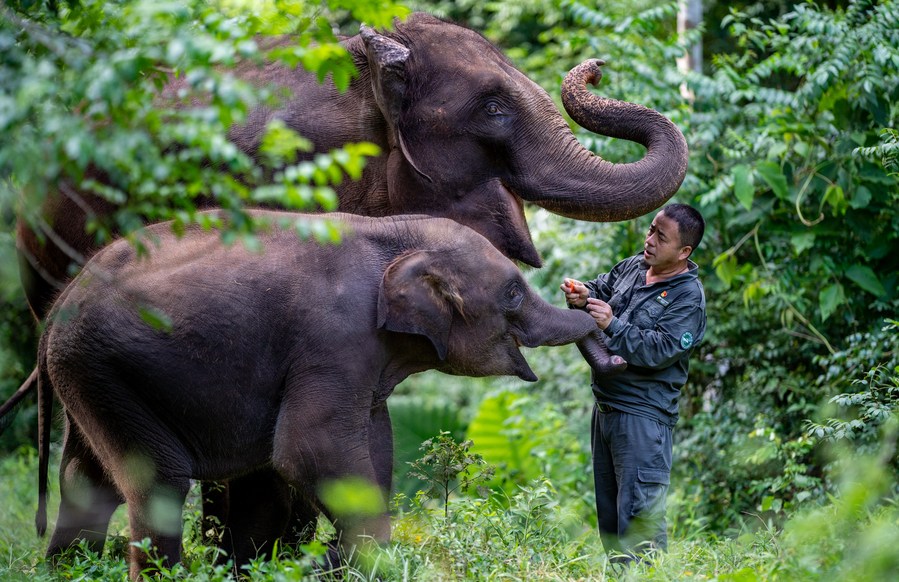
Bao Mingwei, a staff member at the Asian Elephant Breeding and Rescue Center in Xishuangbanna, trains elephants for wild release in southwest China's Yunnan Province, July 28, 2022. (Xinhua/Jiang Wenyao)
BEIJING, Feb. 14 (Xinhua) -- Chinese scientists have discovered that group-living mammal species generally live longer than solitary ones.
Mammals show a 100-fold variation in maximum lifespan, ranging from less than two years in shrews to more than 200 years in bowhead whales. This lifespan gap has attracted many scientific studies aimed at unveiling the reasons for it.
Mammals are the group of animals with the most successful adaptive radiation and the most complete physiological functioning. They are viviparous and female mammals lactate to feed their young. They exhibit more complex social behavior than other animals, and have various forms of social organization.
"Normally, the social organization of mammals can be divided into three basic categories -- solitary, pair-living, and group-living," said Zhou Xuming, a researcher from the Institute of Zoology under the Chinese Academy of Sciences.
In previous studies of social organization and lifespan in mammals, scientists often focused on different groups within a single species. "The results of previous studies, however, were often related to the special life history of specific species, and their universality was limited," Zhou said.
Different from the previous research, the research team led by Zhou performed a phylogenetic comparative analysis of about 1,000 mammalian species including African elephants, ring-tailed lemurs, horseshoe bats and dugongs, based on three states of social organization and longevity, according to a study published in the journal Nature Communications.
In addition to extensive studies of about 1,000 mammalian species, the researchers also conducted transcriptomic analyses on 94 species among them. "We found 31 genes and related pathways involved in hormones and immunity," Zhou said.
He noted that the expression levels and evolutionary rates of these genes and pathways are significantly correlated with social organization and longevity, and may be involved in the association between social organization and longevity.
For example, the solitary northern anura shrews are similar in weight and other conditions to the group-living horseshoe bats. However, the longest lifespan of the shrews is only two years, while that of the bats can be as long as 30 years.
The research results also demonstrated that the transition rate from a short-lived state to a long-lived state is higher in group-living than non-group-living species, also supporting the correlated evolution of social organization and longevity.
Living in groups can also reduce the risk of mammals being preyed upon by other predators or suffering from hunger, and at the same time, it is also beneficial in helping injured, pregnant and old mammals overcome difficulties.
"There is an association between the maximum lifespan of mammals and social organization, but it is not a complete co-evolution," Zhou Xuming pointed out. The factors affecting the lifespan of mammals are very complex, and social organization is not the only factor. ■












